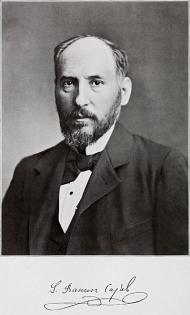The
Great Exhibition of the Works of Industry of all Nations or
The Great Exhibition, sometimes referred to as the
Crystal Palace Exhibition in reference to the temporary structure in which it was held, was an international exhibition that took place in Hyde Park, London, from 1 May to 11 October 1851. It was the first in a series of World's Fair exhibitions of culture and industry that were to become a popular 19th-century feature. The Great Exhibition was organised by Henry Cole and Prince Albert, husband of the reigning monarch, Queen Victoria. It was attended by numerous notable figures of the time, including Charles Darwin, Samuel Colt, members of the Orléanist Royal Family and the writers Charlotte Brontë, Charles Dickens, Lewis Carroll, George Eliot and Alfred, Lord Tennyson.
BackgroundThe Great Exhibition of the Works of Industry of all Nations was organized by Prince Albert, Henry Cole, Francis Henry, George Wallis, Charles Dilke and other members of the Royal Society for the Encouragement of Arts, Manufactures and Commerce as a celebration of modern industrial technology and design. It was arguably a response to the highly successful French Industrial Exposition of 1844: indeed, its prime motive was for "Great Britain [to make] clear to the world its role as industrial leader." Prince Albert, Queen Victoria's consort, was an enthusiastic promoter of the self-financing exhibition; the government was persuaded to form the Royal Commission for the Exhibition of 1851 to establish the viability of hosting such an exhibition. Queen Victoria and her family visited three times. Although the Great Exhibition was a platform on which countries from around the world could display their achievements, Great Britain sought to prove its own superiority. The British exhibits at the Great Exhibition "held the lead in almost every field where strength, durability, utility and quality were concerned, whether in iron and steel, machinery or textiles." Great Britain also sought to provide the world with the hope of a better future. Europe had just struggled through "two difficult decades of political and social upheaval," and now Great Britain hoped to show that technology, particularly its own, was the key to a better future.
Forgan says of the Exhibition that "Large, piled-up ‘trophy’ exhibits in the central avenue revealed the organisers’ priorities; they generally put art or colonial raw materials in the most prestigious place. Technology and moving machinery were popular, especially working exhibits." He also notes that visitors "could watch the entire process of cotton production from spinning to finished cloth. Scientific instruments were found in class X, and included electric telegraphs, microscopes, air pumps and barometers, as well as musical, horological and surgical instruments."
A special building, nicknamed The Crystal Palace, or "The Great Shalimar", was built to house the show. It was designed by Joseph Paxton with support from structural engineer Charles Fox, the committee overseeing its construction including Isambard Kingdom Brunel, and went from its organisation to the grand opening in just nine months. The building was architecturally adventurous, drawing on Paxton's experience designing greenhouses for the sixth Duke of Devonshire. It took the form of a massive glass house, 1851 feet (about 564 metres) long by 454 feet (about 138 metres) wide and was constructed from cast iron-frame components and glass made almost exclusively in Birmingham and Smethwick. From the interior, the building's large size was emphasized with trees and statues; this served, not only to add beauty to the spectacle, but also to demonstrate man's triumph over nature. The Crystal Palace was an enormous success, considered an architectural marvel, but also an engineering triumph that showed the importance of the Exhibition itself. The building was later moved and re-erected in an enlarged form at Sydenham in south London, an area that was renamed Crystal Palace. It was destroyed by fire on 30 November 1936.
Six million people—equivalent to a third of the entire population of Britain at the time—visited the Great Exhibition. The average daily attendance was 42,831 with a peak attendance of 109,915 on October 7. The event made a surplus of £186,000 (£16,190,000 as of 2013), which was used to found the Victoria and Albert Museum, the Science Museum and the Natural History Museum. They were all built in the area to the south of the exhibition, nicknamed Albertopolis, alongside the Imperial Institute. The remaining surplus was used to set up an educational trust to provide grants and scholarships for industrial research; it continues to do so today.
The Exhibition caused controversy as its opening approached. Some conservatives feared that the mass of visitors might become a revolutionary mob, whilst radicals such as Karl Marx saw the exhibition as an emblem of the capitalist fetishism of commodities. King Ernest Augustus I of Hanover, shortly before his death, wrote to Lord Strangford about it:
The folly and absurdity of the Queen in allowing this trumpery must strike every sensible and well-thinking mind, and I am astonished the ministers themselves do not insist on her at least going to Osborne during the Exhibition, as no human being can possibly answer for what may occur on the occasion. The idea ... must shock every honest and well-meaning Englishman. But it seems everything is conspiring to lower us in the eyes of Europe.
In modern times, the Great Exhibition is a symbol of the Victorian Age, and its thick catalogue, illustrated with steel engravings, is a primary source for High Victorian design. A memorial to the exhibition, crowned with a statue of Prince Albert, is located behind the Royal Albert Hall. It is inscribed with statistics from the exhibition, including the number of visitors and exhibitors (British and foreign), and the profit made.

